Modern hands-free cooking technology offers remarkable independence for those with mobility challenges. You’ll find voice-controlled appliances that respond to commands, AI-powered assistants that guide you through recipes, and adaptive tools designed for one-handed use. Smart kitchens now feature automated meal prep systems, adjustable countertops for wheelchair access, and remote monitoring via smartphones. These innovations don’t just make cooking possible—they make it enjoyable and accessible for everyone, regardless of physical limitations.
Voice-Controlled Kitchens: Commanding Your Culinary Space
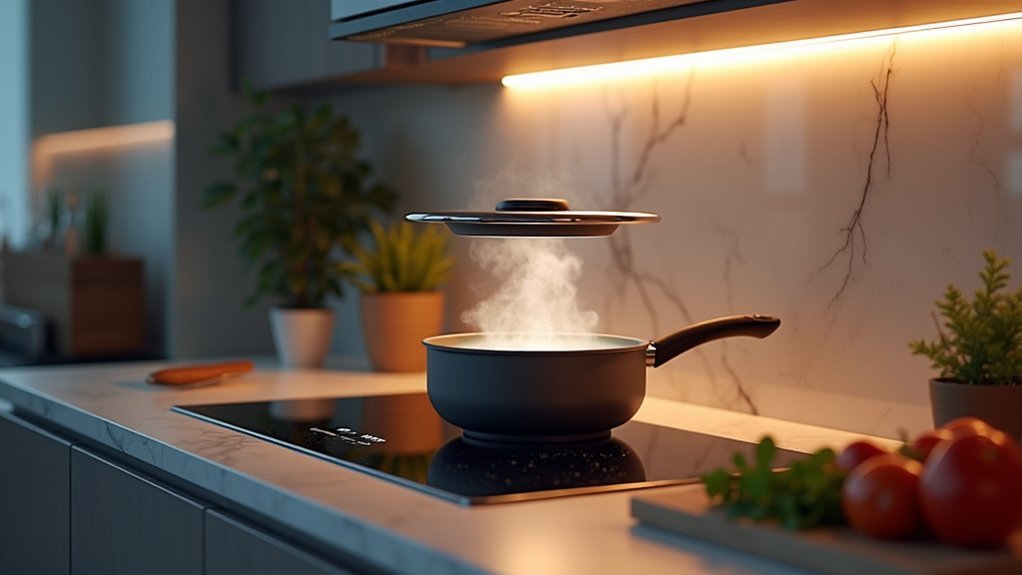
The modern kitchen has evolved into a voice-responsive command center where your words become actions. Major platforms like Amazon Alexa and Google Assistant now integrate seamlessly with your appliances, letting you control ovens, ranges, and microwaves without lifting a finger.
Kitchens now respond to your voice, transforming cooking spaces into command centers through seamless smart assistant integration.
You’ll find voice-activated faucets that adjust water flow and temperature on command, while smart displays guide you through recipes step-by-step. This technology isn’t just convenient—it’s transformative for those with mobility challenges, providing newfound independence. With simple voice commands, you can effortlessly monitor cooking progress without having to repeatedly check on your food manually.
Manufacturers including Whirlpool, GE, and Samsung have embraced this revolution, creating appliances that respond intuitively to your voice.
Beyond efficiency, these systems enhance safety by minimizing physical contact with appliances during messy cooking processes, letting you focus on the joy of creating meals.
Smart Appliances That Respond to Your Needs
Smart kitchens now feature voice-controlled ecosystems that let you command multiple appliances with simple verbal cues, transforming how you prepare meals.
Your appliances’ adaptive learning technology remembers your preferences and adjusts settings automatically, becoming more intuitive with each use.
Remote monitoring solutions allow you to check cooking progress, adjust temperatures, or turn off appliances from anywhere using your smartphone, adding convenience and peace of mind to your culinary routine. This technology is especially appealing to millennial homebuyers who prioritize modern kitchen fittings with advanced technological features.
Voice-Controlled Cooking Ecosystems
While once considered futuristic, voice-controlled cooking ecosystems have rapidly transformed modern kitchens into responsive, intelligent spaces that adapt to your needs.
With 67% of global users now preferring smart kitchen appliances, you’re part of a growing trend embracing hands-free technology.
These systems offer significant benefits beyond convenience. You’ll experience enhanced accessibility if you have mobility challenges, improved safety through hands-free operation during complex tasks, and increased efficiency as AI optimizes your cooking processes. Today’s voice-activated control is increasingly integrated with popular platforms like Alexa and Google Assistant.
The market for these technologies is booming—projected to reach $57.04 billion by 2029, growing at 17.7% annually.
As manufacturers integrate energy-efficient features, compact designs, and augmented reality capabilities, your kitchen becomes increasingly customizable to your preferences, allowing you to control multiple connected devices through simple voice commands.
Adaptive Learning Technology
As kitchens evolve into intelligent hubs, adaptive learning technology has emerged as the cornerstone of truly personalized cooking experiences.
Your smart appliances now study your habits and preferences, adjusting settings automatically to deliver consistent results every time.
When you use your AI-powered oven, it remembers how you like your chicken roasted or cookies baked, fine-tuning temperatures based on your past cooking patterns.
Your refrigerator suggests recipes using ingredients you already have, reducing food waste while catering to your dietary needs.
These intelligent systems don’t just enhance convenience—they improve safety and efficiency too.
They’ll alert you to potential malfunctions before they become dangerous, operate during off-peak hours to save energy costs, and perform automated maintenance checks to extend your appliances’ lifespan.
Voice-controlled features enable you to manage multiple cooking tasks simultaneously with hands-free operation, perfect for busy households or those with mobility limitations.
Remote Monitoring Solutions
The concept of kitchen control has expanded far beyond your home’s physical boundaries. With smart appliances, you’ll receive alerts if you’ve left the refrigerator door open or the oven running, enhancing both safety and energy efficiency. Remote monitoring allows for automatic shut-off capabilities, significantly improving kitchen safety for all users.
| Feature | Benefit | Application |
|---|---|---|
| Interior Cameras | Food inventory at a glance | Check contents while shopping |
| Wireless Connectivity | Control from anywhere | Preheat oven during commute |
| Smart Sensors | Adaptive performance | Adjusts settings based on usage |
These innovations offer unprecedented convenience through smartphone apps and voice assistants like Alexa or Google Assistant. You can schedule operations, customize settings, and monitor energy consumption remotely. For hands-free cooking, this means you’ll maintain independence while ensuring your kitchen remains safe and efficient—even when you’re away.
Automated Meal Prep Systems for Limited Mobility
Automated meal prep systems offer you remarkable independence through one-touch complete solutions that handle everything from measuring to cooking with minimal physical effort.
Voice-activated prepping tools connect to your smart home ecosystem, allowing you to control multiple kitchen functions simultaneously without needing to move around.
Smart chopping technology eliminates one of the most challenging kitchen tasks for those with limited mobility, using precision robotics to dice, slice, and julienne ingredients to your specifications. These automated systems are particularly valuable considering that lonely seniors skip an average of 224 meals per year due to isolation and mobility challenges.
One-Touch Complete Solutions
Modern technology has revolutionized accessibility in the kitchen through one-touch complete solutions—comprehensive automated meal preparation systems specifically engineered for individuals with limited mobility.
These systems integrate advanced robotics and automated devices that minimize manual effort while maximizing independence. You’ll find customizable interfaces that let you select meals and portion sizes according to your preferences, adapting to your unique needs. Many units feature non-slip grips and ergonomic designs similar to traditional adaptive equipment.
The technology incorporates stable platforms with non-slip bases, automated controls for tasks like cutting and peeling, and temperature-regulated cooking processes.
Real-time sensors monitor and adjust cooking parameters, ensuring safety and ideal results.
Voice-Activated Prepping Tools
Voice-activated prepping tools have transformed kitchen accessibility by offering intuitive hands-free solutions for those with limited mobility.
Talking scales announce measurements accurately, enabling precise ingredient portioning without visual confirmation. Smart kettles signal with audible alerts when water reaches boiling point, eliminating the need to constantly monitor.
With Alexa or Google Assistant integration, you’ll gain control over compatible appliances using simple voice commands. Turn on your oven, set timers, or operate microwaves without physical interaction. Users should consider adding an automatic pan stirrer to their smart kitchen setup for complete hands-free cooking capabilities.
These systems greatly enhance independence while improving safety by reducing physical contact with potentially dangerous equipment.
Accessible recipe systems deliver cooking instructions through audio output, making meal preparation possible for those with visual impairments.
As AI advances continue, expect even more sophisticated voice-controlled kitchen solutions tailored to your specific needs.
Smart Chopping Technology
Smart chopping technology represents a revolutionary breakthrough for individuals with limited mobility, transforming what was once a physically demanding kitchen task into an effortless experience.
These AI-powered systems employ robotic arms and machine vision to chop ingredients precisely and safely, adapting to different food textures and sizes. You’ll appreciate the built-in safety features like collision detection that prevent accidents while you’re preparing meals.
By integrating these devices into your kitchen, you’ll gain independence and efficiency without physical strain. The latest models often include 28 cooking functions that go beyond chopping to provide complete meal preparation capabilities. Many systems offer customizable options to match your dietary preferences.
Companies like Standard Bots and Posha are leading this growing market with user-friendly interfaces and IoT connectivity.
As this technology evolves, you can expect even more AI-driven adaptability and seamless integration with your existing smart home systems.
Customized Kitchen Setups for Wheelchair Users
Creating an accessible kitchen requires thoughtful planning that goes beyond standard designs to accommodate the unique needs of wheelchair users.
Designing truly inclusive kitchens means seeing beyond conventional layouts to embrace functionality for everyone’s unique mobility needs.
You’ll need adequate clear floor space with at least a 1500mm turning circle for easy maneuvering. Set countertops between 28-34 inches high with minimal thickness, and guarantee sinks have knee clearance underneath.
Choose cabinets with pull-out shelves, lazy Susans, and easy-grip handles to transform hard-to-reach spaces into accessible storage. Touch-release doors can significantly improve accessibility compared to traditional knobs that require more dexterity.
Install appliances strategically – wall ovens at mid-level height, cooktops with front controls, and refrigerators with side-opening doors or drawer options.
Don’t forget safety features like slip-resistant flooring, rounded countertop edges, and lever-style faucets.
Multiple counter heights can serve different needs, while keeping frequently used items within 15-48 inches from the floor minimizes strain.
AI-Powered Cooking Assistants: Your Virtual Sous Chef

You’ll find AI-powered cooking assistants transforming your kitchen experience through intuitive voice commands that guide you step-by-step through recipes without requiring you to touch screens or cookbooks.
When you’re missing an ingredient, these virtual sous chefs instantly suggest smart substitutions based on what’s available in your pantry while maintaining the dish’s flavor profile.
Your dietary restrictions and taste preferences are remembered, allowing the AI to recommend alternatives that align perfectly with your needs. The Upliance BundleUp takes this convenience further with its 8-inch touchscreen that displays in-built recipes and provides detailed instructions for effortless meal preparation.
Voice-Guided Recipe Navigation
As technology transforms home cooking, voice-guided recipe navigation has emerged as a game-changer for busy home chefs. You’re joining the 92% of users who leverage AI voice assistants for hands-free cooking experiences, allowing you to focus on preparation while your virtual sous chef guides you step by step.
These intelligent systems aren’t limited to basic instructions—they’re revolutionizing how you interact with recipes:
- Voice activation enables completely hands-free operation when your fingers are covered in ingredients.
- Interactive recipe building personalizes dishes based on your dietary preferences.
- Cross-device integration means you can start a recipe on your phone and continue on your kitchen smart display.
- AI-generated recipe innovations introduce you to unexpected flavor combinations you wouldn’t discover otherwise.
This technology has significantly improved independence for people with disabilities, with 1 in 3 consumers with visual impairments utilizing voice assistants on a weekly basis to enhance their cooking experience.
Smart Ingredient Substitutions
When you’re midway through preparing a meal and discover you’re missing an essential ingredient, AI-powered cooking assistants become your culinary lifesaver.
These tools achieve 95% accuracy in recommending suitable alternatives while reducing meal prep time by 40%.
Your AI assistant analyzes chemical compositions and flavor affinities to suggest unexpected yet harmonious substitutions tailored to your dietary restrictions or allergies. Using advanced algorithms and a comprehensive flavor database, the AI can create combinations that human chefs might not imagine but that work surprisingly well together.
Simply input what you’re missing, and you’ll receive personalized alternatives with preparation tips.
These smart systems integrate with your kitchen appliances to automatically adjust cooking times and temperatures based on your substitutions.
Visual recognition can even identify ingredients through your camera, enabling real-time decisions as you cook.
With AI substitution tools, you’ll save an average of 35% on food costs through reduced waste and ideal use of what’s already in your pantry.
Remote Monitoring: Cook With Confidence From Anywhere
Modern technology has revolutionized the way we monitor our cooking processes, giving us unprecedented freedom in the kitchen. With IoT-powered remote monitoring systems, you’ll never worry about leaving something in the oven again.
These smart solutions offer you:
- Real-time temperature tracking and alerts sent directly to your phone when conditions deviate
- Historical data logging for optimizing your favorite recipes and ensuring compliance with food safety standards
- Seamless integration with existing kitchen appliances through wireless sensors and cloud platforms
- Significant cost savings by preventing food waste from overcooking or spoilage
Whether you’re managing a restaurant kitchen or simply multitasking at home, remote monitoring technology lets you step away with confidence, knowing your culinary creations are under perfect surveillance. The extensive wireless range of modern sensors allows you to monitor temperatures from anywhere in your home or business without connectivity concerns.
Adaptive Utensils and Holders for Enhanced Grip
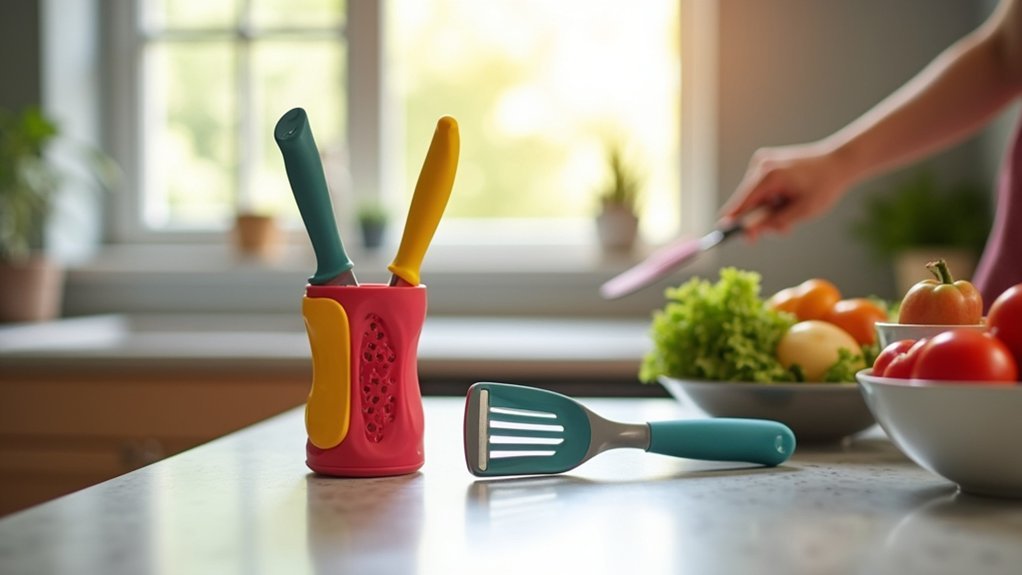
While traditional kitchen tools often present challenges for those with limited dexterity or strength, adaptive utensils and specialized holders have transformed cooking accessibility.
You’ll find options with built-up silicone handles, curved designs, and weighted features that reduce tremors and hand fatigue while improving stability.
For one-handed cooking, rocker knives and palm peelers distribute force across your palm rather than requiring precise finger movements.
Universal cuff holders can secure utensils to your hand, enabling independent use even without a firm grip.
These tools aren’t just practical—they’re affordable too, with many options under $25.
Some even incorporate technology like tremor-stabilizing electronics.
Products like the PalmPeeler Vegetable Peeler exemplify tools designed specifically for ergonomic designs that prioritize comfort and accessibility.
One-Touch Cooking Programs for Simplified Meal Creation
One-touch cooking programs take kitchen accessibility to the next level, moving beyond adaptive utensils to completely hands-free meal preparation.
These systems simplify your cooking experience through smart technology and intuitive design.
With modern one-touch programs, you’ll enjoy:
- Automatic mode selection that detects your food type and adjusts cooking parameters accordingly
- Programmable recipes with image guidance that guarantee consistent results every time
- Real-time feedback through digital displays that let you monitor cooking progress without constant checking
- Smart safety features like auto-shut-off and overheating protection
Touchscreen controls and capacitive buttons make operation effortless, while Wi-Fi connectivity in advanced models allows remote management. The Tovala Smart Oven exemplifies this technology by offering multiple cooking modes including Bake, Broil, Air Fry, Toast, and Reheat.
These innovations aren’t just convenient—they’re transformative for those with mobility limitations, offering true culinary independence through technology.
Sensor Technology: When Timing Is Everything
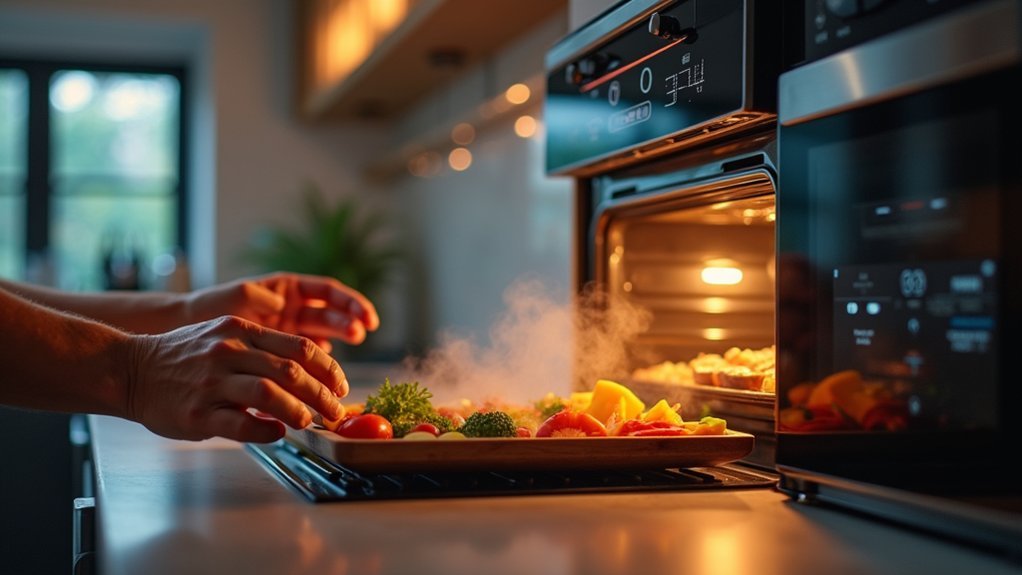
Sophisticated sensor technology has revolutionized hands-free cooking, transforming imprecise methods into scientific precision. You’ll find microwave sensors that detect moisture levels, automatically adjusting cooking times to prevent overcooking your favorite dishes.
Your smart appliances now monitor temperature, humidity, and weight in real-time, making continuous adjustments without your intervention. When you’re using devices like the Thermomix Sensor paired with the TM6, you’ll experience guided cooking with exact temperature control. Modern kitchen equipment often incorporates sensors installed directly in cooking basins to provide precise control of cooking temperatures for pasta and deep-fried foods.
The benefits extend beyond convenience—you’ll enjoy enhanced food safety, reduced energy consumption, and consistently perfect results.
These smart sensors provide real-time feedback through connected apps, reducing your stress about timing and temperature management. With sensor technology handling the critical timing aspects, you’ll gain newfound confidence in your cooking abilities.
Smart Storage Solutions for Accessible Ingredients
The revolution in smart kitchens extends beyond timing to how you store and access ingredients. With the kitchen storage market valued at $131.43 billion and growing at 4.8% annually, innovative solutions now focus on maximizing accessibility in your cooking space.
Today’s smart storage technologies enhance your meal preparation through:
- Voice-activated or app-controlled systems that help you quickly locate ingredients
- Modular containers with digital labeling and inventory tracking
- Pullout waste and recycling drawers (planned by 67% of remodeling homeowners)
- Automatic replenishment alerts integrated with your kitchen ecosystem
These advancements are particularly valuable if you have mobility limitations, as they eliminate reaching and searching while promoting independence in the kitchen.
Smart storage combines efficiency with accessibility, transforming how you interact with ingredients. The integration with voice assistants is a key innovation driving market growth, allowing hands-free operation for users of all abilities.
The Future of Adaptive Cooking Technology
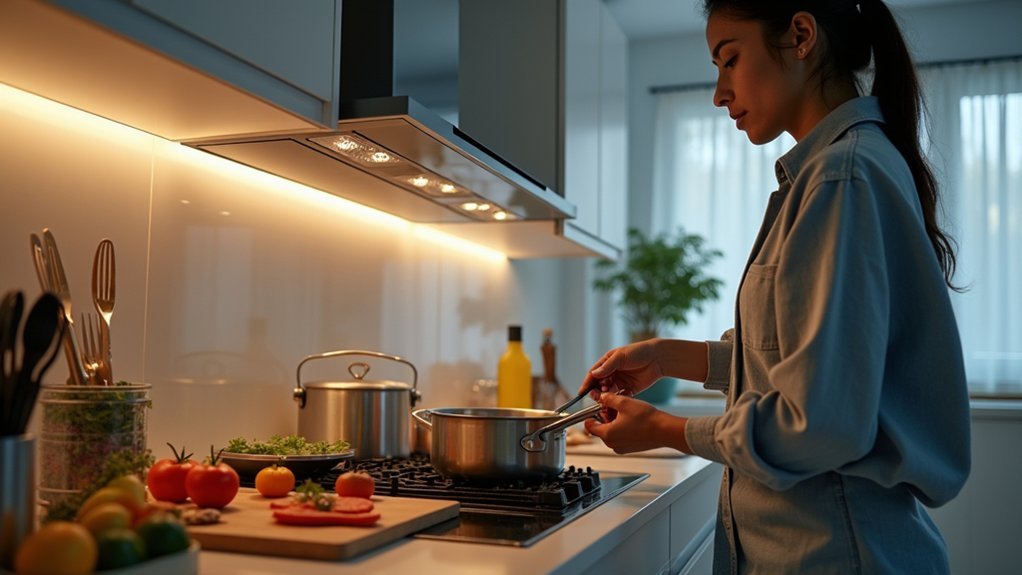
As we enter a new era of kitchen innovation, adaptive cooking technology stands poised to transform how you prepare meals at home. Your kitchen will anticipate needs before you express them, with appliances that integrate seamlessly with your calendar and health records to optimize cooking processes.
You’ll experience truly hands-free cooking through gesture controls and motion sensors that adjust settings automatically. Seniors and people with disabilities will gain independence through adaptive technology that responds to their unique needs. Your appliances will learn your preferences, creating personalized cooking environments while prioritizing safety with automatic shutdowns when potential hazards are detected.
AI-driven meal planning will customize recipes based on your genetic profile and available ingredients, reducing waste and enhancing nutrition.
These smart ecosystems won’t just make cooking easier—they’ll revolutionize how you interact with your kitchen, balancing convenience with sustainability through energy-efficient operations and eco-friendly practices.
Building Your Hands-Free Kitchen on Any Budget
Creating a hands-free kitchen doesn’t require emptying your savings account or securing a second mortgage.
Whether you’re working with a modest budget or ready to invest in premium features, you’ll find options that match your financial comfort zone.
For budget-conscious renovations, consider:
- Affordable touchless faucets from brands like Moen that offer motion sensors
- Simple DIY sensor installations for basic hands-free functionality
- Smart speakers like Amazon Alexa to control compatible appliances
- Refurbished smart appliances that provide advanced features at reduced prices
Installing foot-pedal cabinets provides an economical entry point into touchless kitchen technology while maintaining convenience and hygiene benefits.
As your budget increases, you can explore Wi-Fi connected appliances, automatic cabinet systems with advanced sensors, and extensive smart home integration.
Remember to balance aesthetic considerations with functionality—sleek faucet designs and hidden foot pedals maintain a minimalist look while enhancing your hands-free experience.
Frequently Asked Questions
How Do Smart Kitchens Protect User Privacy and Cooking Data?
Smart kitchens protect your privacy through device encryption, secure networks, and regular security updates. You’ll maintain control with user consent options, while TEE technology and strong passwords prevent unauthorized access to your cooking data.
Can Hands-Free Appliances Integrate With Special Dietary Tracking Apps?
Yes, your hands-free appliances can integrate with dietary tracking apps through APIs and wireless connectivity. They’ll automatically log nutritional data, sync with diet plans, and suggest recipe modifications to support your specific dietary needs and restrictions.
What Backup Systems Exist When Voice Recognition Fails?
When voice recognition fails, you’ve got multiple backups: manual interfaces on smart displays, physical buttons, portable cooking devices like butane stoves, offline recipe storage apps, and traditional kitchen tools that don’t require technology at all.
How Are Emergency Shutoffs Handled in Fully Automated Cooking Systems?
You’ll find automated cooking systems incorporate both automatic and manual emergency shutoffs. They integrate with fire suppression, use temperature sensors for auto-triggers, include manual overrides, and comply with safety regulations to protect you and your equipment.
Are Smart Kitchen Devices Compatible With Older Home Electrical Systems?
Most smart kitchen devices work with older electrical systems as they comply with standard voltages. You’ll only need upgrades if you’re installing high-power appliances (above 2.2kW) or if your circuits can’t handle additional load.
In Summary
Embracing hands-free cooking technology isn’t just about convenience—it’s about reclaiming your independence. Whether you’re starting with voice commands or investing in fully automated systems, you’ll find options that fit your needs and budget. As these innovations continue to evolve, you’re not just adapting to limitations—you’re overcoming them. Your kitchen can become a place of empowerment, where disability doesn’t dictate what’s possible.

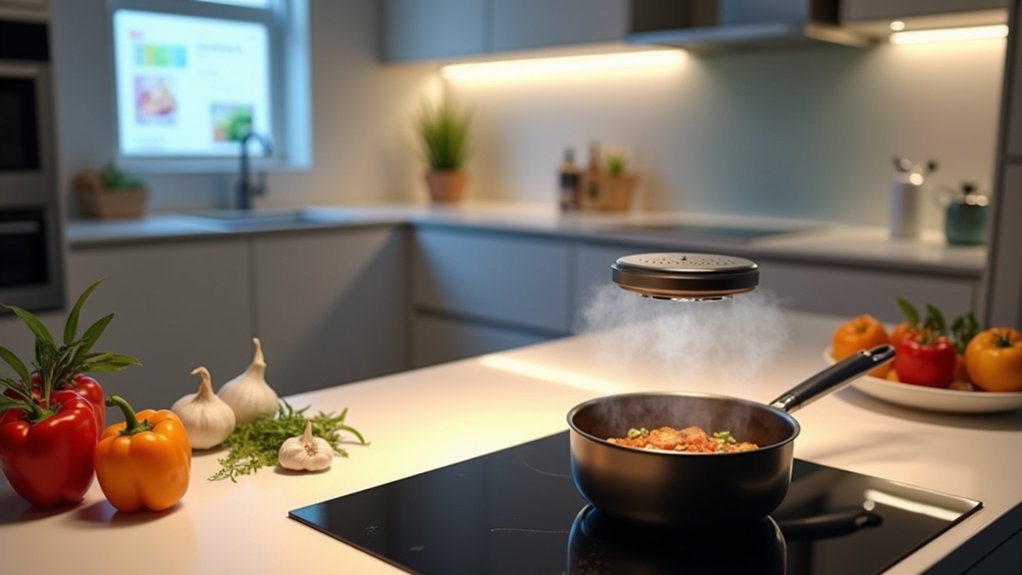



Leave a Reply